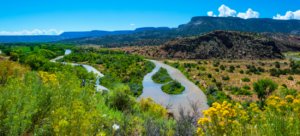
By Garrett Veneklasen
A proposal to aerially apply pesticides to kill native grasshoppers on federal public lands in the Rio Chama Watershed has sparked significant public outcry for the second year in a row. In January, the U.S. Department of Agriculture’s Animal and Plant Health Inspection Service (APHIS) announced this year’s proposal, which is aimed at increasing forage for cattle on public land. The public response to this project was overwhelmingly negative, with over 1,640 individuals voicing opposition during the public comment period.
The affected area includes 25,000 acres in the Cebolla area of Rio Arriba County on primarily Bureau of Land Management (BLM) lands, along with some state land and private property. The area is popular for outdoor recreation, including fishing, boating, hiking, camping, and hunting, and includes the Rio Chama Wilderness Study Area and the Chama Canyons Area of Critical Environmental Concern. The spray would occur in close proximity to the Rio Chama Wild and Scenic River, the Chama River Canyon Wilderness, the Jicarilla Apache Nation, and an Important Bird Area, as designated by the National Audubon Society.
APHIS proposes to use four different chemicals for the project: carbaryl, chlorantraniliprole, diflubenzuron, and malathion. Commenters emphasized a particular opposition to carbaryl, citing potential harm to non-target species. Carbaryl is highly toxic to all terrestrial and aquatic insects, as well as mammals, fish, birds and larval amphibians. Carbaryl is also a likely human carcinogen and has been known to cause nausea, headaches, dizziness, anxiety, and mental confusion, as well as convulsions, coma and respiratory depression.
Additional public concerns revolve around the lack of transparency and public involvement in the decision-making process. Many individuals emphasized the need for a comprehensive analysis of the project’s impacts on a variety of sensitive resources, publicly accessible survey data that demonstrates a need for grasshopper control, and a thorough economic justification before any pesticide use is considered. They stressed that APHIS should develop scientifically sound survey plans and promptly make data available to the public.
The New Mexico Environment Department also weighed in with concerns. “The proposed affected area in Rio Arriba County includes the Chama River Canyon Wilderness. The stream segments and wetlands in the Chavez Canyon, Ojitos Canyon, and the Rio Chama within the Chama River Canyon Wilderness are classified as Outstanding Natural Resource Waters (ONRWs),” the Department said in their comments. “Pesticide applications should avoid and provide adequate buffer to water bodies, wetlands and riparian zones, playas and internal draining wetlands (depressions), tributaries, arroyos, acequias and other drainageways to water bodies, and wetlands.”
The public outcry underscores the importance of moving away from widespread use of harmful pesticides toward sustainable solutions that protect biodiversity and public health, and a need for much improved transparency and public engagement in APHIS projects affecting federal public lands and resources. New Mexico Wild commends the BLM Taos Field Office for halting last year’s spray, citing the need for additional environmental analysis and public transparency. We are optimistic that our public land managers will make the same sound decision this year.
We are in the midst of a global mass extinction crisis. The numbers of myriad bird species, from pinyon jays to pygmy nuthatches and hummingbirds, are plummeting at an alarming rate. Critical and iconic pollinators like monarchs and native bee numbers are also in an alarming state of decline. All of these species and many others are the foundation of a critical ecological web of ecosystem health and functionality. The idea of intentionally killing millions of invertebrate species using harmful and carcinogenic pesticides is nothing short of diabolical. The unintended consequences of such a reckless action are far reaching and morally reprehensible.
Federal and state agency policies that intentionally destroy and degrade land, water and wildlife have no place in today’s world. Respectfully reach out to interim Taos BLM Field Manager Eric Valencia at evalencia@blm.gov and BLM State Director Melanie Barnes mgbarnes@blm.gov and tell them to deny APHIS’s request to use pesticides in the Chama this year or any time in future years. As the land manager in this area, BLM has the final say on when or if this shameful practice will happen.
Garrett Veneklasen is the northern conservation director for New Mexico Wilderness Alliance. He lives in Taos.
This op-ed was published in the Taos News on June 5th, 2024.

